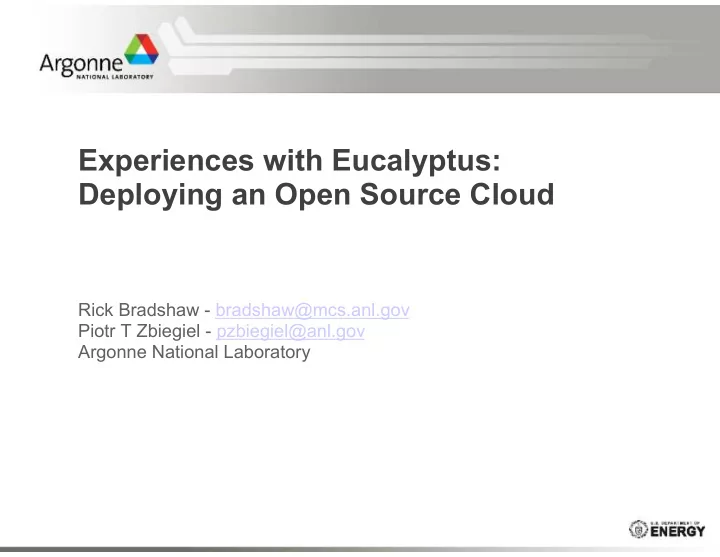

Experiences with Eucalyptus: Deploying an Open Source Cloud Rick Bradshaw - bradshaw@mcs.anl.gov Piotr T Zbiegiel - pzbiegiel@anl.gov Argonne National Laboratory
Overview • Introduction and Background • Eucalyptus experiences and observations o Scalability o Security o Support • Our chosen support model • Conclusions and future work
Introduction • Clouds for scientific computing? o Magellan Project buy or build • What cloud software is available? o Different Cloud APIs EC2 ( http://aws.amazon.com/ec2/ ) Rackspace (http://www.rackspacecloud.com/?CMP=Google_rackspace+cloud_exact ) Nimbus ( http://www.nimbusproject.org/ ) many more out there • Why did we choose Eucalyptus? o EC2 compatibility o Open Source / Free o UEC from Ubuntu
Eucalyptus 1.6.2
Eucalyptus Scalability: Cluster sizes • Tested Eucalyptus with various sized clusters (40, 80, 160, 240 nodes behind one cluster controller) All-around performance best with smaller clusters • Performance deteriorated as clusters size grew due to iterative operations • Eucalyptus instance termination operation is serial • o Instances that don ’ t terminate in a timely manner are communicated to all nodes o The process delays other activities while it works on terminating instances o Naturally, larger clusters result in longer execution times for such operations o Instance requests which never left the cluster controller due to errors are still “ terminated ” on the node controllers!
Eucalyptus Scalability: Load Testing Load tests were done to stress the software. • Eucalyptus performed acceptably given enough time to complete requests • • Rapid churning (starting and stopping instances) gives Eucalyptus heartburn. Ran into hard limit on a single cluster controller • o Somewhere between 750 and 800 running VMs o Caused by message size limitation in cloud and cluster controller communication protocol
Security: Network Security Eucalyptus network mode: MANAGED-NOVLAN • VM network traffic masquerades as Cluster Controller • • By default, VMs can communicate with Node Controllers and other internal systems. (BAD) iptables rules on node controllers • o prevents VMs from making unwanted connections o No impact to cloud operation
Security: IDS • Risk areas identified for the VMs • Outside IPs scanning/attacking VMs • VMs scanning/attacking outside IPs • VMs running suspect services • Eucalyptus MANAGED-NOVLAN network model provides suitable IDS access IDS watches internal Cluster Controller interface • Monitors all inbound and outbound traffic to the VMs • Also monitors communication between security groups • • Can not see VMs communicating within a security group.
Security: Image Security Concerns Users can upload and register customized disk images • Sys Admins must register kernel and ramdisk images • Uploaded images automatically made public • o Users must choose to change permissions o Contents of image can be inadvertently leaked Users can upload compromised images • o A myriad of ways to backdoor o Bucket naming is fairly open o This even happened accidentally Users can upload images with exploitable vulnerabilities • o Every user is a sys admin o We can recommend but not require best practices
User Support
User Support • We chose a community based support model o forums( still haven't found one everyone agrees on ) o wikis o mailing lists o best effort documentation • The difference between Job support and OS/VM support o the complexity is greatly increased o learning curve for users is steep o pre-built images do not always work without effort Kernels KVM vs. Xen startup environment
Conclusions • Works but still evaluating other solutions o Nimbus o OpenStack • Don't believe the hype o every cloud stack has its qualities and faults o usage/API should help make the choice
Recommend
More recommend